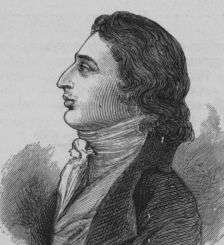Goldilocks and the Three Bears
"Goldilocks and the Three Bears" (originally titled "The Story of the Three Bears") is a British 19th-century fairy tale of which three versions exist. The original version of the tale tells of a badly-behaved old woman who enters the forest home of three bachelor bears whilst they are away. She sits in their chairs, eats some of their porridge, and sleeps in one of their beds. When the bears return and discover her, she wakes up, jumps out of the window, and is never seen again. The second version replaced the old woman with a little girl named Goldilocks, and the third and by far best-known version replaced the original bear trio with Papa Bear, Mama Bear and Baby Bear (who is not actually an infant, but rather a small cub).
| "Goldilocks and the Three Bears" | |
|---|---|
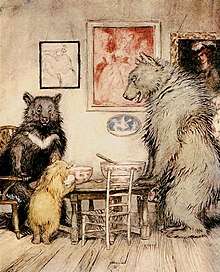 Illustration by Arthur Rackham, 1918 | |
| Author | Robert Southey |
| Country | United Kingdom |
| Genre(s) | Fairy tale |
| Published in | The Doctor |
| Publication type | Essay and story collection |
| Publisher | Longman, Rees, etc. |
| Media type | |
| Publication date | 1837 |
What was originally a frightening oral tale became a cozy family story with only a hint of menace. The story has elicited various interpretations and has been adapted to film, opera, and other media. "Goldilocks and the Three Bears" is one of the most popular fairy tales in the English language.[1]
Plot
In Robert Southey's version of the tale, three anthropomorphic bears – "a little, small, wee bear, a middle-sized bear, and a great, huge bear" – live together in a house in the woods. Southey describes them as very good-natured, trusting, harmless, tidy, and hospitable. Each of these "bachelor" bears has his own porridge bowl, chair, and bed. One day they make porridge for breakfast, but it is too hot to eat, so they decide to take a walk in the woods while their porridge cools. An old woman approaches the bears' house. As she has been sent out by her family, she is a disgrace to them. She is impudent, bad, foul-mouthed, ugly, dirty, and a vagrant deserving of a stint in the House of Correction. She looks through a window, peeps through the keyhole, and lifts the latch. Assured that no one is home, she walks in. The old woman eats the Wee Bear's porridge, then settles into his chair and breaks it. Prowling about, she finds the bears' beds and falls asleep in Wee Bear's bed. The end of the tale is reached when the bears return. Wee Bear finds his empty bowl, his broken chair, and the old woman sleeping in his bed and cries, "Somebody has been lying in my bed, and here she is!" The old woman wakes, jumps out the window and is never seen again.
Origins
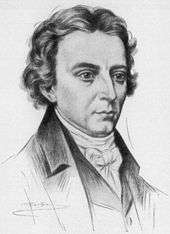
The story was first recorded in narrative form by British writer and poet Robert Southey, and first published anonymously as "The Story of the Three Bears" in 1837 in a volume of his writings called The Doctor.[2] The same year Southey's tale was published, the story was versified by George Nicol, who acknowledged the anonymous author of The Doctor as "the great, original concocter" of the tale.[3][4] Southey was delighted with Nicol's effort to bring more exposure to the tale, concerned children might overlook it in The Doctor.[5] Nicol's version was illustrated with engravings by B. Hart (after "C.J."), and was reissued in 1848 with Southey identified as the story's author.[6]
The story of the three bears was in circulation before the publication of Southey's tale.[7] In 1813, for example, Southey was telling the story to friends, and in 1831 Eleanor Mure fashioned a handmade booklet about the three bears and the old woman for her nephew Horace Broke's birthday.[3] Southey and Mure differ in details. Southey's bears have porridge, but Mure's have milk;[3] Southey's old woman has no motive for entering the house, but Mure's old woman is piqued when her courtesy visit is rebuffed;[8] Southey's old woman runs away when discovered, but Mure's old woman is impaled on the steeple of St Paul's Cathedral.[9]
Folklorists Iona and Peter Opie point out in The Classic Fairy Tales (1999) that the tale has a "partial analogue" in "Snow White": the lost princess enters the dwarfs' house, tastes their food, and falls asleep in one of their beds. In a manner similar to the three bears, the dwarfs cry, "Someone's been sitting in my chair!", "Someone's been eating off my plate!", and "Someone's been sleeping in my bed!" The Opies also point to similarities in a Norwegian tale about a princess who takes refuge in a cave inhabited by three Russian princes dressed in bearskins. She eats their food and hides under a bed.[10]
In 1865, Charles Dickens referenced a similar tale in Our Mutual Friend, but in that story the house belongs to hobgoblins rather than bears. Dickens' reference however suggests a yet-to-be-discovered analogue or source.[11] Hunting rituals and ceremonies have been suggested and dismissed as possible origins.[12][13]
In 1894, "Scrapefoot", a tale with a fox as antagonist that bears striking similarities to Southey's story, was uncovered by the folklorist Joseph Jacobs and may predate Southey's version in the oral tradition. Some sources state that it was illustrator John D. Batten who in 1894 reported a variant of the tale at least 40 years old. In this version, the three bears live in a castle in the woods and are visited by a fox called Scrapefoot who drinks their milk, sits in their chairs, and rests in their beds.[3] This version belongs to the early Fox and Bear tale-cycle.[14] Southey possibly heard "Scrapefoot", and confused its "vixen" with a synonym for an unpleasant malicious old woman. Some maintain however that the story as well as the old woman originated with Southey.[2]
Southey most likely learned the tale as a child from his uncle William Tyler. Uncle Tyler may have told a version with a vixen (female fox) as the intruder, and then Southey may have later confused "vixen" with another common meaning of "a crafty old woman".[3] P. M. Zall writes in "The Gothic Voice of Father Bear" (1974) that "it was no trick for Southey, a consummate technician, to recreate the improvisational tone of an Uncle William through rhythmical reiteration, artful alliteration ('they walked into the woods, while'), even bardic interpolation ('She could not have been a good, honest Old Woman')".[15] Ultimately, it is uncertain where Southey or his uncle learned the tale.
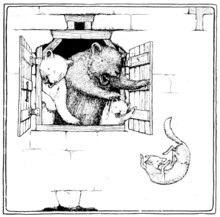
Later variations: Goldilocks
Twelve years after the publication of Southey's tale, Joseph Cundall transformed the antagonist from an ugly old woman to a pretty little girl in his Treasury of Pleasure Books for Young Children. He explained his reasons for doing so in a dedicatory letter to his children, dated November 1849, which was inserted at the beginning of the book:
The "Story of the Three Bears" is a very old Nursery Tale, but it was never so well told as by the great poet Southey, whose version I have (with permission) given you, only I have made the intruder a little girl instead of an old woman. This I did because I found that the tale is better known with Silver-Hair, and because there are so many other stories of old women.[10]
Once the little girl entered the tale, she remained – suggesting children prefer an attractive child in the story rather than an ugly old woman.[5] The juvenile antagonist saw a succession of names:[16] Silver Hair in the pantomime Harlequin and The Three Bears; or, Little Silver Hair and the Fairies by J. B. Buckstone (1853); Silver-Locks in Aunt Mavor's Nursery Tales (1858); Silverhair in George MacDonald's "The Golden Key" (1867); Golden Hair in Aunt Friendly's Nursery Book (ca. 1868);[10] Silver-Hair and Goldenlocks at various times; Little Golden-Hair (1889);[14] and finally Goldilocks in Old Nursery Stories and Rhymes (1904).[10] Tatar credits Flora Annie Steel with naming the child (1918).[2]
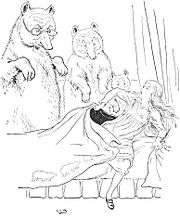
Goldilocks's fate varies in the many retellings: in some versions, she runs into the forest, in some she is almost eaten by the bears but her mother rescues her, in some she vows to be a good child, and in some she returns home. Whatever her fate, Goldilocks fares better than Southey's vagrant old woman who, in his opinion, deserved a stint in the House of Correction, and far better than Miss Mure's old woman who is impaled upon a steeple in St Paul's church-yard.[17]
Southey's all-male ursine trio has not been left untouched over the years. The group was re-cast as Papa, Mama, and Baby Bear, but the date of this change is disputed. Tatar indicates it occurred by 1852,[17] while Katherine Briggs suggests the event occurred in 1878 with Mother Goose's Fairy Tales published by Routledge.[14][16] With the publication of the tale by "Aunt Fanny" in 1852, the bears became a family in the illustrations to the tale but remained three bachelor bears in the text.
In Dulcken's version of 1858, the two larger bears are brother and sister, and friends to the little bear. This arrangement represents the evolution of the ursine trio from the traditional three male bears to a family of father, mother, and child.[18] In a publication ca. 1860, the bears have become a family at last in both text and illustrations: "the old papa bear, the mama bear, and the little boy bear".[19] In a Routledge publication c 1867, Papa Bear is called Rough Bruin, Mama Bear is Mammy Muff, and Baby Bear is called Tiny. Inexplicably, the illustrations depict the three as male bears.[20]
In publications subsequent to Aunt Fanny's of 1852, Victorian nicety required editors to routinely and silently alter Southey's "[T]here she sate till the bottom of the chair came out, and down came her's, plump upon the ground" to read "and down she came", omitting any reference to the human bottom. The cumulative effect of the several changes to the tale since its original publication was to transform a fearsome oral tale into a cozy family story with an unrealised hint of menace.[16]
Interpretations
Maria Tatar, in The Annotated Classic Fairy Tales (2002), notes that Southey's tale is sometimes viewed as a cautionary tale that imparts a lesson about the hazards of wandering off and exploring unknown territory. Like "The Tale of the Three Little Pigs", the story uses repetitive formulas to engage the child's attention and to reinforce the point about safety and shelter.[17] Tatar points out that the tale is typically framed today as a discovery of what is "just right", but for earlier generations, it was a tale about an intruder who could not control herself when encountering the possessions of others.[21]
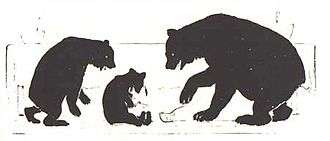
In The Uses of Enchantment (1976), the child psychologist Bruno Bettelheim describes Goldilocks as "poor, beautiful, and charming", and notes that the story does not describe her positively except for her hair.[22] Bettelheim mainly discussed the tale in terms of Goldilocks' struggle to move past Oedipal issues to confront adolescent identity problems.[23]
In Bettelheim's view, the tale fails to encourage children "to pursue the hard labor of solving, one at a time, the problems which growing up presents", and does not end as fairy tales should with the "promise of future happiness awaiting those who have mastered their Oedipal situation as a child". He believes the tale is an escapist one that thwarts the child reading it from gaining emotional maturity.
Tatar criticises Bettelheim's views: "[His] reading is perhaps too invested in instrumentalizing fairy tales, that is, in turning them into vehicles that convey messages and set forth behavioral models for the child. While the story may not solve oedipal issues or sibling rivalry as Bettelheim believes "Cinderella" does, it suggests the importance of respecting property and the consequences of just 'trying out' things that do not belong to you."[17]
Elms suggests Bettelheim may have missed the anal aspect of the tale that would make it helpful to the child's personality development.[22] In Handbook of Psychobiography Elms describes Southey's tale not as one of Bettelheimian post-Oedipal ego development but as one of Freudian pre-Oedipal anality.[23] He believes the story appeals chiefly to preschoolers who are engaged in "cleanliness training, maintaining environmental and behavioral order, and distress about disruption of order". His own experience and his observation of others lead him to believe children align themselves with the tidy, organised ursine protagonists rather than the unruly, delinquent human antagonist. In Elms's view, the anality of "The Story of the Three Bears" can be traced directly to Robert Southey's fastidious, dirt-obsessed aunt who raised him and passed her obsession to him in a milder form.[23]
Literary elements
The story makes extensive use of the literary rule of three, featuring three chairs, three bowls of porridge, three beds, and the three title characters who live in the house. There are also three sequences of the bears discovering in turn that someone has been eating from their porridge, sitting in their chairs, and finally, lying in their beds, at which point is the climax of Goldilocks being discovered. This follows three earlier sequences of Goldilocks trying the bowls of porridge, chairs, and beds successively, each time finding the third "just right". Author Christopher Booker characterises this as the "dialectical three", where "the first is wrong in one way, the second in another or opposite way, and only the third, in the middle, is just right". Booker continues: "This idea that the way forward lies in finding an exact middle path between opposites is of extraordinary importance in storytelling".[24] This concept has spread across many other disciplines, particularly developmental psychology, biology, economics and engineering where it is called the "Goldilocks principle". In planetary astronomy, a planet orbiting its sun at just the right distance for liquid water to exist on its surface, neither too hot nor too cold, is referred to as being in the 'Goldilocks Zone'.
Adaptations
- The MGM cartoons of the late 1930s included a Bear Family subseries by Hugh Harman based on the story, starting with Goldilocks and the Three Bears (1939), then continuing on to A Rainy Day with the Bear Family (1940) and Papa Gets the Bird (1941). The MGM character of Barney Bear, originating concurrently, was at times advertised as being this Bear Family's Papa, though creator Rudolf Ising appears to have always intended him as a separate character.
- A shortfilm by Terrytoons titled The Three Bears was released in 1939. This short depicts the bears as having Italian accents and mannerisms. The short had gained internet meme status in more recent years for the sequence in which the family return home to discover that somebody had been eating their spaghetti, papa bear exclaiming "somebody touched my spaghett!"
- The Looney Tunes and Merrie Melodies cartoons include a prominent Three Bears family, distinguished by a short, irascible father, a deadpan mother, and a huge, oafish seven-year-old "baby," still in diapers.
- Songwriter Bobby Troup's hipster interpretation titled "The Three Bears", first recorded by Page Cavanaugh in 1946, is often erroneously credited to "anonymous" and re-titled "Three Bears Rap", "Three Bears with a Beat", etc.
- The three bears may or may not have been the inspiration for Stan and Jan Berenstain's Berenstain Bears.
- The 1993 PC game Sesame Street: Numbers features a Sesame Street-esque twist on the story, and it is found in one of the three books in the game. Titled Count Goldilocks and the 3 Bears, it features the Count von Count taking the role of Goldilocks, as "Count Goldilocks". Instead of arriving after Papa, Mama, and Baby Bear go on their picnic, he arrives before they go out. He then proceeds to count them, their picnic baskets, wooden chairs, and beds. Each time he is done counting one of them, he asks why they have three of what he counted. At the end, Baby Bear says that they have three of everything because they are three bears. Then, they finally go on their picnic in the woods.
- Kurt Schwertsik's 35-minute opera Roald Dahl's Goldilocks premiered in 1997 at the Glasgow Royal Concert Hall. The opera's setting is the Forest Assizes where Baby Bear stands accused of assaulting Miss Goldie Locks. The tables are turned when the defence limns the trauma suffered by the bears at the hands of that "brazen little crook", Goldilocks.[25]
- In Rooster Teeth Productions RWBY, Yang Xiao Long is a carefree, reckless yellow-haired girl.[26] She is a "rule-breaker" who likes teddy bears. She is an allusion to Goldilocks which is reflected in her name, translated from Chinese as "sun", referring to the colour yellow.[27] Also, in her trailer, Yang confronts Hei "Junior" Xiong, whose name is Chinese for "black bear." Combining this with his nickname, he alludes to the Baby Bear.
- The TV show Happily Ever After: Fairy Tales for Every Child featured an adaption of "Goldilocks and the Three Bears" in a Jamaican setting which featured the voices of Raven-Symoné as Goldilocks, Tone Loc as Desmond Bear, Alfre Woodard as Winsone Bear, and David Alan Grier as Dudley Bear.
- In an episode of Sesame Street, a reversed version of the story titled "Baby Bear and the Three Goldilocks" was told (and written) by Telly and Elmo.
- A fractured version of the story was made for Jay Ward's Fractured Fairy Tales, in which Goldilocks had a winter resort and the three bears invade for hibernation purposes; Papa Bear was short and short-tempered, Mama Bear was more even-tempered, and Baby Bear was a huge, oversized dope who was "not sleepy".
- The television show Hello Kitty's Furry Tale Theater Kittylocks and the Three Bears is an adaptation of the story.
- "Goldilocks Eats Grits" has the bears living in a cave in Georgia in the United States.[28]
- A commercial for the 2005 Hummer portrayed the Three Bears returning from a family trip to their very upscale home to discover all the elements of the traditional story. They race to their garage to check on the status of the family Hummers. Mama Bear and Papa Bear are relieved that both vehicles are still in place, but Baby Bear is distraught to find his missing as the camera cuts away to Goldilocks (in this version portrayed by a very attractive young woman) rakishly smiling as she makes her getaway in Baby Bear's Hummer down a scenic mountain road.
- In 2014, MC Frontalot released a hip-hop rendition of the story as part of the album, Question Bedtime, in which the narrator warns the three bears of a ruthless woman called Gold Locks who hunts and eats bear cubs. An official music video was uploaded in 2015.[29]
- In 2016, professional wrestler Bray Wyatt read a dark version to Edge and Christian.[30]
- Disney Junior's Goldie & Bear premiered in 2016. The tale is set after the events of the story where Goldilocks (voiced by Natalie Lander) and Jack Bear (voiced by Georgie Kidder) eventually became best friends.
See also
References
Citations
- Elms 1977, p. 257
- Tatar 2002, p. 245
- Opie 1992, p. 199
- Ober 1981, p. 47
- Curry 1921, p. 65
- Ober 1981, p. 48
- Dorson 2001, p. 94
- Ober 1981, pp. 2,10
- Opie 1992, pp. 199–200
- Opie 1992, p. 200
- Ober 1981, p. xii
- Ober 1981, p. x
- Elms 1977, p. 259
- Briggs 2002, pp. 128–129
- Quoted in: Ober 1981, p. ix
- Seal 2001, p. 91
- Tatar 2002, p. 246
- Ober 1981, p. 142
- Ober 1981, p. 178
- Ober 1981, p. 190
- Tatar 2002, p. 251
- Elms 1977, p. 264
- Schultz 2005, p. 93
- Booker 2005, pp. 229–32
- Roald Dahl's Goldilocks
- Webb, Charles (1 June 2013). "EXCLUSIVE: Rooster Teeth's 'RWBY' Yellow Trailer". MTV. Archived from the original on 9 June 2013. Retrieved 10 June 2013.
- Rush, Amanda (12 July 2013). "FEATURE: Inside Rooster Teeth's "RWBY"". Crunchyroll. Retrieved 18 July 2013.
- Friedman, Amy; Johnson, Meredith (25 January 2015). "Goldilocks Eats Grits". Universal Uclick. Retrieved 25 January 2015.
- MC Frontalot (23 September 2014), MC Frontalot - Gold Locks (ft. Jean Grae) [OFFICIAL VIDEO], retrieved 11 March 2019
- "Bray Wyatt tells a twisted fairy tale on the Edge & Christian Show, only on WWE Network". 2 May 2016.
Bray Wyatt puts a diabolical spin on 'Goldilocks and the Three Bears' on The Edge & Christian Show
Sources
- The Seven Basic Plots. Booker, Christopher (2005). "The Rule of Three". The Seven Basic Plots: Why We Tell Stories. Continuum International Publishing Group. ISBN 0-8264-5209-4.
- Briggs, Katherine Mary (2002) [1977]. British Folk Tales and Legends. Routledge. ISBN 0-415-28602-6.
- "Coronet: Goldilocks and the Three Bears". Internet Archive. Retrieved 21 February 2009.
- Curry, Charles Madison (1921). Children's Literature. Rand McNally & Company. p. 179.
three bears.
- "Disney: Goldilocks and the Three Bears". The Encyclopedia of Disney Animated Shorts. Archived from the original on 22 February 2013. Retrieved 21 February 2009.
- Dorson, Richard Mercer (2001) [1968]. The British Folklorists. Taylor & Francis. ISBN 0-415-20426-7.
- Elms, Alan C. (July–September 1977). ""The Three Bears": Four Interpretations". The Journal of American Folklore. 90 (357). JSTOR 539519.
- "MGM: Goldilocks and the Three Bears". Retrieved 12 November 2010.
- Ober, Warren U. (1981). The Story of the Three Bears. Scholars Facsimiles & Reprints. ISBN 0-8201-1362-X.
- Opie, Iona; Opie, Peter (1992) [1974]. The Classic Fairy Tales. Oxford University Press. ISBN 0-19-211559-6.
- "Roald Dahl's Goldilocks (1997)". Retrieved 3 January 2009.
- Schultz, William Todd (2005). Handbook of Psychobiography. Oxford University Press. ISBN 0-19-516827-5.
- Seal, Graham (2001). Encyclopedia of Folk Heroes. ABC-CLIO. ISBN 1-57607-216-9.
- Tatar, Maria (2002). The Annotated Classic Fairy Tales. W.W. Norton & Company. ISBN 0-393-05163-3.
External links
| Wikisource has original text related to this article: |
| Wikisource has original text related to this article: |
| Wikimedia Commons has media related to The Three Bears. |
- "The Story of the Three Bears", manuscript by Eleanor Mure, 1831 - first recorded version
- "The Story of the Three Bears" by Robert Southey, 1837 – first published version
- "The Story of the Three Bears", versified by George Nicol, 2nd edition, 1839 (text)
- "The Three Bears" by Robert Southey – later version with "Silver-hair", a "little girl"
- "Goldilocks and the Three Bears", by Katharine Pyle, 1918 – later version with father, mother and baby bear
- "Goldilocks Three Bears and its Writer Robert Southey"
